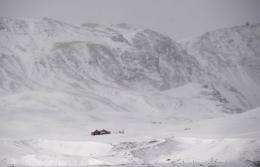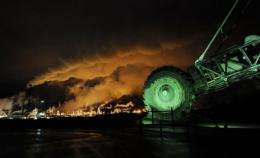Hoping for mining boom, Canada opens last frontier

Dropping beneath low-lying clouds, a float plane circles a rocky landscape on the edge of the Arctic Circle grooved by the last ice age eight millennia ago and since then bathed by hundreds of rivers and lakes.
Tiny points of light emerge in the distance, pointing the way to Azimut Exploration's NCG or Nunavik Copper Gold prospecting camp in the far north of Canada's Quebec province.
Quebec unveiled an $80-billion plan in May to open up its vast northern region -- one of the world's last unspoiled wilds, about twice the size of France -- to forestry and mining.
There is currently only one mine in operation in Nunavik, the northern third of the province of Quebec: Xstrata's Raglan, which opened in 1997.
But China's state-owned Jilin Jien Nickel recently invested $800 million to mine nickel starting next year near the Inuit village of Kangiqsujuaq.
And the Quebec government promises up to 11 new mining projects will be launched in the next few years in the far north.
Tiny Azimut, with only six employees, has emerged as a leader in the Nunavik tundra by partnering with mining giants such as Aurizon Mines, IAMGOLD, Rio Tinto and Goldcorp to prospect for gold, copper, nickel, cobalt, platinum, zinc, iron ore, diamonds, lithium, vanadium and rare earth metals.
Tents at Azimut's NCG prospecting camp 1,600 kilometers (1,000 miles) north of Montreal were set up only three months ago, but are already starting to be taken down before the arrival of winter when temperatures will fall to minus 40 Celsius (minus 40 Fahrenheit).
Nearby a caribou grazes at a lake's edge, unfazed by visitors, while bold Arctic foxes scavenge the camp for carrots.
Veteran prospector Jean Fortin has just arrived at the camp and is canvassing a table covered with rock samples. "That's really interesting," he exclaims, picking up a rock sheered from a nearby ridge that could be hiding a major gold or copper find.

"Nunavik still remains substantially unexplored," says geologist and Azimut president Jean-Marc Lulin. "So there's an opportunity to make important discoveries here."
The new efforts come as the government is proposing to upgrade 10 north ports, 46 airstrips and extend railroads and roads by tens of thousands of kilometers (miles) to improve access to the region.
Azimut holds prospecting rights to 7,500 square kilometers (2,900 square miles) of land about 140 kilometers (86 miles) east of the Inuit village of Puvirnituq, and invited AFP to visit its prospecting operations in the area accessible only by plane.
The company's goal is straightforward: discover promising ore deposits and partner with other mining companies at an early stage to develop the targets.
Its two other nearby camps, Rex and Rex South, offer unexpected comforts: toilets, showers, washing machine, dishwasher, Internet and a satellite telephone.
"It's required," explains Lulin, "Otherwise, it's just too hard on the guys."
Alcohol is forbidden at the camps, but the food is delicious and the fish is very fresh.
The men spend much of their downtime plucking "monster" fish from nearby lakes, and later regaling friends and families with stories about trout or Arctic char "this big!" Lulin says, arms outstretched -- or about their encounters with wolves or black bears.
Or they just sit back and marvel at the spectacular display of the aurora borealis.
The geological work itself is arduous, and made more difficult by harsh weather and swarms of biting insects.
After one year of prospecting at Rex South, Azimut partner Aurizon Mines has agreed to invest five million dollars over the next five years to develop the target.
"It's going well," Aurizon geologist Olivier Grondin tells Lulin before boarding a helicopter to scout a potentially significant outcrop of gold, silver, copper and tungsten in a zone named the Augossan corridor.
"We're very excited because there's a potential to discover a vast amount (of minerals) near the surface," explains Lulin.
Only deposits on the surface can be extracted in this region at a profit, with prohibitive costs of building mine infrastructure to tap resources deep underground.
"Unless it's a major find, it's not worth it," Lulin says.
(c) 2011 AFP




















